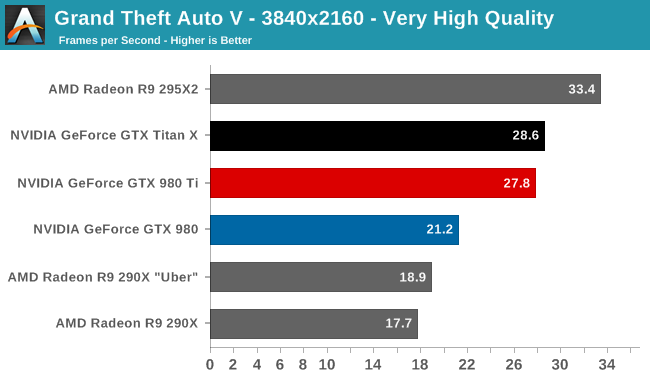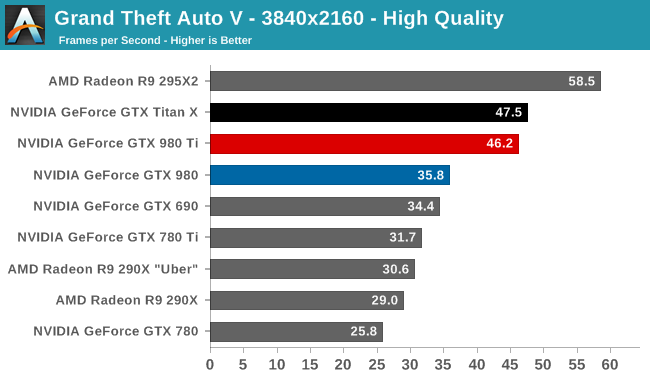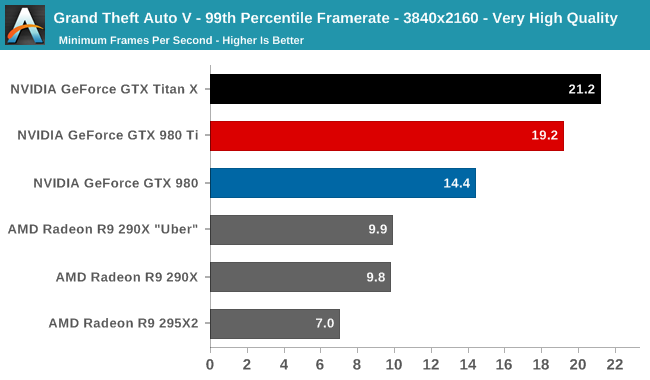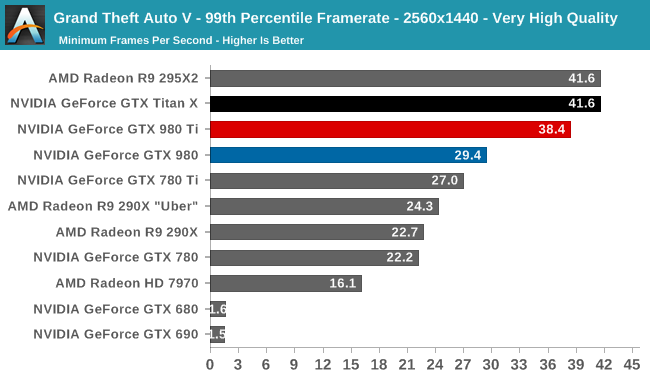The NVIDIA GeForce GTX 980 Ti Review
by Ryan Smith on May 31, 2015 6:00 PM ESTGrand Theft Auto V
The final game in our review of the GTX 980 Ti is our most recent addition, Grand Theft Auto V. The latest edition of Rockstar’s venerable series of open world action games, Grand Theft Auto V was originally released to the last-gen consoles back in 2013. However thanks to a rather significant facelift for the current-gen consoles and PCs, along with the ability to greatly turn up rendering distances and add other features like MSAA and more realistic shadows, the end result is a game that is still among the most stressful of our benchmarks when all of its features are turned up. Furthermore, in a move rather uncharacteristic of most open world action games, Grand Theft Auto also includes a very comprehensive benchmark mode, giving us a great chance to look into the performance of an open world action game.
On a quick note about settings, as Grand Theft Auto V doesn't have pre-defined settings tiers, I want to quickly note what settings we're using. For "Very High" quality we have all of the primary graphics settings turned up to their highest setting, with the exception of grass, which is at its own very high setting. Meanwhile 4x MSAA is enabled for direct views and reflections. This setting also involves turning on some of the advanced redering features - the game's long shadows, high resolution shadows, and high definition flight streaming - but it not increasing the view distance any further.
Otherwise for "High" quality we take the same basic settings but turn off all MSAA, which significantly reduces the GPU rendering and VRAM requirements.



After initially expecting Grand Theft Auto to be a walk in the park performance wise, the PC version of the game has instead turned out to be a very demanding games for our GPUs. Even at 1440p we can’t have very high quality with MSAA and still crack 60fps, though we can get very close.
Ultimately GTA doesn’t do any better than any other game in setting apart our GM200 cards. GTX 980 Ti trails GTX Titan by 4% or less, essentially the average outcome at this point. Also average is the GTX 980 Ti’s lead over the GTX 980, with the newest card beating the older GTX 980 by 29-31% across our three settings. Finally, against the GTX 780 the GTX 980 Ti has another strong showing, with a 69-79% lead.
On an absolute basis we can see that at 4K we can’t have 4x MSAA and even crack 30fps on a single-GPU card, with GTX 980 Ti topping out at 27.8 fps. Taking out MSAA brings us up to 46.2fps, which is still well off 60fps, but also well over the 30fps cap that this game was originally designed against on the last-generation consoles.



Along with an all-around solid benchmark scene, the other interesting benchmarking feature of GTA is that it also generates frame percentiles on its own, allowing us to see the percentiles without going back and recording the game with FRAPS. Taking a look at the 99th percentile in this case, what we find is that at each setting GTA crushes some group of cards due to a lack of VRAM.
At 4K very high quality, 4GB cards have just enough VRAM to stay alive, with the multi-GPU R9 295X2 getting crushed due to the additional VRAM requirements of AFR pushing it over the edge. Not plotted here are the 3GB cards, which saw their framerates plummet to the low single-digits, essentially struggling to complete this benchmark. Meanwhile 1440p at high quality crushes our 2GB cards, with less VRAM than a Radeon HD 7970 falling off of the cliff.
As for what this means for the GTX 980 Ti, the situation finds the GTX 980 Ti trailing the GTX Titan X in 99th percentile framerates by anywhere between 3% and 10%. This test is not designed to push more than 6GB of VRAM, so I’m not entirely convinced this isn’t a wider than normal variance (especially at the low framerates for 4K), though the significant and rapid asset streaming this benchmark requires may be taking its toll on the GTX 980 Ti, which has less VRAM for additional caching.










290 Comments
View All Comments
Kosiostin - Monday, June 1, 2015 - link
I beg to differ. 4K at monitor viewing distance is not overkill, it's actually quite pleasantly sharp. Phones, tablets and laptops are already pushing for 2K+ displays which is phenomenally sharp and out of the league for normal FHD monitors. Gaming at 4K is still not coming but when it comes it will blow our minds, I am sure.Oxford Guy - Monday, June 1, 2015 - link
People who care so much for immersion should be using 1440 with HDTV screen sizes, not sitting way up close with small monitors.Too bad HDTVs have so much input lag, though.
Kutark - Monday, June 1, 2015 - link
Basically at a 5' viewing distance, you would have to have a 40" monitor before 4k would start to become noticeable.Even at 30" monitor you would have to be sitting roughly 3.5' or closer to your monitor to be able to begin to tell the difference.
We also have to keep in mind we're talking about severely diminishing returns. 1440p is about perfect for normal seating distances with a computer on a 27" monitor. 30" some arguments can be made for 4k but its a minor. Its not like we're going from 480p to 1080p or something 1440p is still very good at "normal" computer seating distances.
mapesdhs - Wednesday, June 3, 2015 - link
Human vision varies as to who can discern what at a particular distance. There's no fixed cutoffs for this. Personally, when wandering around a TV store back in January (without knowing what type of screen I was looking at), for visual clarity the only displays that looked properly impressive turned out to be 4Ks. However, they're still a bit too pricey atm for a good one, with the cheaper models employing too many compromises such as reduced chroma sampling to bring down the pricing, or much lower refresh rates, etc. (notice how stores use lots of static imagery to advertise their cheaper 4K TVs?)Btw, here's a wonderfull irony for you: recent research, mentioned in New Scientist, suggests that long exposure by gamers to high-refresh displays makes them more able to tell the difference between standard displays and high-refresh models, ie. simply using a 144Hz monitor can make one less tolerant of standad 60Hz displays in the long term. :D It's like a self-reinforcing quality tolerance level. Quite funny IMO. No surprise to me though, years working in VR & suchlike resulted in my being able to tell the difference in refresh rates much more than I was able to beforehand.
Anyway, I'm leaving 4K until cheaper models are better quality, etc. In the meantime I bought a decent (but not high-end) 48" Samsung which works pretty well. Certainly looks good for Elite Dangerous running off a 980, and Crysis looks awesome.
Laststop311 - Monday, June 1, 2015 - link
Why would most people be using DVI? DVI is big and clunky and just sucks. Everyone that gets new stuff nowadays uses displayport it has the easiest to use plug.Crest - Sunday, May 31, 2015 - link
Thank you for including the GTX580. I'm still living and working on a pair of 580's and it's nice to know where they stand in these new releases.TocaHack - Monday, June 1, 2015 - link
I upgraded from SLI'd 580s to a 980 at the start of April. Now I'm wishing I'd waited for the Ti! It wasn't meant to launch this soon! :-/mapesdhs - Wednesday, June 3, 2015 - link
Indeed, one of the few sites to include 580 numbers, though it's a shame it's missing in some of the graphs (people forget there are lots of 3GB 580s around now, I bought ten last month).If it's of any use, I've done a lot of 580 SLI vs. 980 (SLI) testing, PM for a link to the results. I tested with 832MHz 3GB 580s, though the reference 783MHz 3GB models I was already using I sold for a nice profit to a movie company (excellent cards for CUDA, two of them beat a Titan), reducing the initial 980 upgrade to a mere +150.
Overall, a 980 easily beats 580 SLI, and often comes very close to 3-way 580 SLI. The heavier the load, the bigger the difference, eg. for Firestrike Ultra, one 980 was between 50% and 80% faster than two 3GB 580s. I also tested 2/3-way 980 SLI, so if you'd like the numbers, just PM me or Google "SGI Ian" to find my site, contact page and Yahoo email adr.
I've been looking for a newer test. I gather GTA V has a built-in benchmark, so finally I may have found something suitable, need to look into that.
Only one complaint about the review though, why no CUDA test??? I'd really like to know how the range of NV cards stacks up now, and whether AE yet supports MW CUDA V2. I've tested 980s with Arion and Blender, it came close to two 580s, but not quite. Would be great to see how the 980 Ti compares to the 980 for this. Still plenty of people using CUDA with pro apps, especially AE.
Ian.
mapesdhs - Wednesday, June 3, 2015 - link
Btw Crest, which model 580s are you using? I do have some 1.5GB 580s aswell, but I've not really done much yet to expose where VRAM issues kick in, though it does show up in Unigine pretty well at 1440p.For reference, I do most testing with a 5GHz 2700K and a 4.8GHz 3930K, though I've also tested three 980s on a P55 with an i7 870 (currently the fastest P55 system on 3DMark for various tests).
Mikemk - Sunday, May 31, 2015 - link
Since it has 2 SMM's disabled, does it have the memory issue of the 970? (Haven't read full article yet, sorry if answered in article)